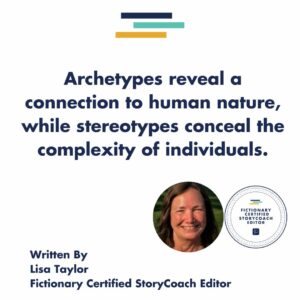
Let’s address what we mean by archetype vs stereotype.
Archetypes and stereotypes could be trapped in the battle between form and formula.
Archetypes provide a powerful model for future heroes, while stereotypes create bonds to constrain stock characters. But is it that easy? Are archetypes like angels guiding the writer to character complexity while stereotypes drag them demonically down to the hell of the hack writer and pulp fiction?
Before we start twisting to Chuck Berry, let’s take a closer look at how these two concepts describing a type of person are different.
More importantly, let’s discover how you can use these types to create characters to enhance your stories. Yes, understanding the difference between archetypes and stereotypes will help develop compelling and relatable characters – but how?

Archetype vs Stereotype: The Good (Archetypes)
An archetype is a pattern that is present in the psyche of all humans, according to Carl Jung’s theories.
In literature, that pattern in human nature creates a sense of immediate familiarity. Without having to wonder why we recognize it, we relate to these archetypes.
As Cyrano pines for Rosalind, we recognize the emotion of unrequited love. As Cinderella becomes the princess, we recognize the rise from rags to riches, which is one of seven major plot or story archetypes.
Character archetypes provide a set of common traits that provide a recognizable foundation.
The hero, villain, antihero, sage or mentor and trickster are only a few of the archetypes readers will know. The archetype is the model, an idealized version from which copies are modeled, and this is a key thing to note in the discussion of archetype vs stereotype.
The archetypal hero fights against evil to restore peace, harmony, and justice.
From this archetype rise ancient heroes like Hercules, as well as modern heroes like Harry Potter or Katniss Everdeen. Similarly, the sage, with wisdom and insight to help the protagonist is seen in Merlin, Gandalf and Yoda.
With archetypes, our knowledge of the specific and identifiable traits doesn’t lead to a predictable outcome. Instead, these archetypes provide a link between this character and something bigger than the individual.
Here are two of many other archetypes to consider in your writing:
- The Caregiver: Someone who supports others and sacrifices for them. While loyal and selfless, this archetype lacks in personal ambition and drive. Some caregivers include Mary Poppins and Mrs. Weasley, from the Harry Potter series.
- The Innocent: Usually a child, the innocent is kind and morally good, but usually naïve and vulnerable. Two familiar innocents in literature are Prim Everdeen in The Hunger Games series and Lennie from Of Mice and Men.

Archetype vs Stereotype: Stereotypes (The Bad)
Now you know what an archetype is when we talk about archetype vs stereotype, let’s look at their opposite number.
Stereotypes grow out of generalizations.
Whether positive or negative, the over-simplification created by stereotypes hampers understanding of the individual.
Drawn from perceived similarities within a group, stereotypes reduce a complex group into a homogeneous type. Human beings are complex and stereotypes limit our willingness to deepen our understanding of others.
In life, stereotypes create prejudice and narrow-mindedness. In literature, stereotypes can weaken character development and may promote harmful generalizations about a group or culture.
This is the danger of a single story spoken about by Chimamanda Ngozi Adichie. The dangers of stereotypes are real, as is the power of a story.
Now you can really see why this article is called archetype vs stereotype. While these two concepts may seem similar at first glance, they couldn’t be more different.
Instead of using stereotypes, consider stock characters.
Still, based on a limited and predictable frame, the stock character can act as a foil for the protagonist or play another role in moving the plot forward.
Stock characters, that rise from the masked exaggerated characters in commedia dell’arte, are oversimplified to create a quickly recognized character. Because of this simplification, they are usually flat and don’t change over the course of the story.
When editing your story, look at your stock characters and ask yourself:
- Could they develop?
- Would a clear foil for the protagonist enhance the story?
- What would work for your story?
A few of the many stock characters in the archetype vs stereotype debate include: absent-minded professor, mad scientist, boy or girl next door, geek, goon, nerd, hotshot and lovable loser.

Characters: The Ugly, the Beautiful and Everything In Between
Archetypes, stock characters, and stereotypes offer writers a shorthand connection between their characters and their readers.
Archetypes provide a frame for the writer.
Within that recognized frame, the writer has space to create the unique character for their story.
The archetype can empower the character, giving them a place in history beyond the story. The archetypal character can be a major or minor character, the protagonist or the antagonist.
Through the archetype, the writer has a character who drives the narrative forward with relatable motivations and traits.
REMEMBER! Archetype vs Stereotype: an archetype is a recognised pattern of character behaviour and a stereotype is a generalization
Stock characters provide a framework to create a quick understanding of a character.
Using the expected framework, writers might keep within the generalized structure to give a minor character some sense of life or they might challenge the structure to show the complexity of a character and to challenge the reader’s expectations.
Stock characters are often flat characters, but that doesn’t mean they aren’t memorable or important to your story.
As L. Cooke writes in this blog, characters, like Miss Havisham in Dickens’ Great Expectations, are remembered despite not developing during the story. Sometimes, they are remembered because they do not change or grow!
An oversimplified representation of an occupation, role, or type, the stereotype may give a writer a flat supporting character who may not even have a name.
For instance, a brisk army medic who gives first aid and vital information to the wounded hero on the way from the battlefield. As mentioned above, the use of stereotypes must be done with awareness of the damage caused by oversimplification. If the stereotype might add to negative assumptions and prejudice or jar your reader out of the story, make a change.

Archetype vs Stereotype: The Conclusion
A sensitivity read or reader may be an option if you have any concerns or doubts about your characters.
Archetypes, stock characters and stereotypes can aid the reader in gaining a quick sense of a character; use these tools wisely. Remember, archetypes reveal a connection to human nature, while stereotypes conceal the complexity of individuals.
Looking for where to go next in creating great characters? Then, check out this blog by Polly Watt: How to Create Compelling Characters
Article Written by Lisa Taylor

Stories are powerful. Through my experience as an educator and librarian, I’ve explored how stories work and supported writers in finding their voices and honing their craft.
As a Fictionary Certified StoryCoach Editor, I offer a thorough, objective structural story edit that honours your voice, recognises and celebrates your skill, and offers clear, actionable ideas on ways to make your story shine even more. You can reach me through the Fictionary Online Community.

